Daily News
by Gail Helmer
[ Send Us News | Archives ]
Medal of Honor SP Demo Released
Blues News has reported that the single-player demo of Medal of Honor: Allied Assault has surfaced online a day or so ago, apparently uploaded from a foreign magazine's cover CD-ROM. While it was originally not intended to be released online so soon, the massive 175 MB ZIP download is available for download here.
Silent Hunter 2 Project V2.0
Naval Warfare Simulations has that the NWS Silent Hunter 2 Project V2.0 is now posted. Several new graphics, sounds, and data updates with this latest version.
Military News
Global Hawk Crashes After Afghan Mission
A US Air Force RQ-4A Global Hawk unmanned aerial vehicle on a routine mission in support of US operations in Afghanistan crashed at 0830 GMT on 30 December. According to US Central Command it was returning to its undisclosed operating base when the accident occurred.
Central Command said the crash was "...not the result of enemy fire and the aircraft will be recovered."
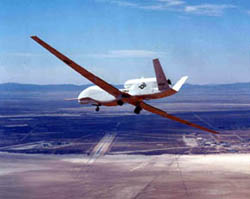
The Global Hawk is an unmanned reconnaissance and surveillance system designed to provide military commanders with high resolution, near real-time imagery of large geographic areas. Still in its development phase, it has been pressed into service because of its long endurance over a target.
The aircraft was one of two in the theatre.
Osprey To Enter Two-Year Flight Test Programme
The troubled V-22 Osprey aircraft will go through a two-year flight test programme, said Pete Aldridge, US Defense Undersecretary for acquisition, technology and logistics.
"I've had some serious doubts about the safety, reliability and operational suitability of the V-22," Aldridge said during a Pentagon press conference Dec. 21. "I personally still have some doubts, but the only way to prove the case is to put the airplane back into flight test, and we're going to do that."
Marine Corps plans to buy 360 and Navy and Air Force plans to buy 50 each of the tilt-rotor aircraft were put on hold following two crashes that killed 23 Marines in April and December 2000.
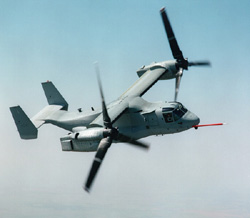
Several "blue ribbon" groups that looked into the crashes and the programme have recommended a number of changes.
The new flight test programme will start in April 2002. It will be a comprehensive, two-year look at the aircraft. The tests will further explore the occurrence called vortex ring state, deemed responsible for the first crash of a V- 22 in Arizona that killed 19 Marines.
Aldridge said the tests also must explore shipboard compatibility. For example, he noted the need to look at what happens when one rotor is over the flight deck and the other is over the side of the ship, conditions which could include take-off, landing or craft on deck.
He wants the test to also explore low-speed hover conditions, such as landing when the props blow up dust, debris, snow and other things. The testing will also include combat manoeuvrability and formation flying, including refueling conditions.
Aldridge said he and Navy Secretary Gordon England would assess the testing programmes at various posts along the way. He said the flight-test hurdles would be event-driven rather than schedule-driven. Tests will not move to new areas until engineers fully understand the results of earlier testing.
"We'll not be driven by trying to accomplish something in a certain period of time," he said.
DoD has slowed down production of the V-22 to the minimum sustaining level. This will allow changes to be made to production aircraft. Aircraft already built will be retrofitted.
JASSM Gets Go-Ahead For Low-Rate Initial Production
US Undersecretary of Defense Pete Aldridge has given the Joint Air-to-Surface Standoff Missile (JASSM) programme the go-ahead for low-rate initial production. This decision will give the Air Force combat capability on the F-16 Fighting Falcons and B-52 Stratofortresses by 2003.
JASSM is a joint Air Force and Navy programme developed and produced by Lockheed-Martin Integrated Systems. JASSM employs stealth to penetrate enemy air defences at ranges of more than 200 miles and GPS coupled with a terminal seeker to attack high-value targets. Unlike current cruise missiles, JASSM can be launched off most types of aircraft in the Air Force inventory. The 2,000-pound class weapon is planned for deployment on the B-1B Lancer, B-2 Spirit, B-52, F-16, and the Navy's F/A-18 E/F Hornet.
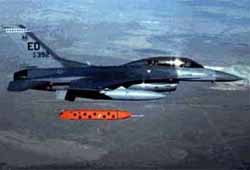
"We have a low-cost, high performance programme and we came in below the objective of $400K in (fiscal) '95 dollars," said Terry Little, JASSM Air Force programme director. As a result, the Air Force has increased its buy from 2,400 to 3,700 missiles.
"JASSM is a flagship programme for acquisition excellence," said Dr. James G. Roche, secretary of the Air Force. "Not only do our combat forces get an unprecedented precision attack capability, but they get it at an affordable price never before achieved on a cruise missile program".
Air Force officials said the service plans to make the decision for full-rate production in late 2003.
Raytheon Aircraft Awarded T-6A Contract
Raytheon Aircraft has been awarded its largest military contract ever -- a one-year contract with four one-year options for the production of more than 230 T-6A Texan II aircraft, associated ground-based training devices and technical support. The one-year contract for 40 aircraft is valued at $193 million and when all options are exercised the total potential value will be approximately $1.22 billion.
The Joint Primary Aircraft Training System (JPATS) program calls for nearly 800 aircraft through the year 2017. To date, the U.S. Air Force and U.S. Navy have ordered 168 aircraft. This most recent contract, with options, covers the production of an additional 234 aircraft and ground-based training devices through the years 2002-2006, with deliveries beginning in 2004. The total value of the acquisition program to date, including options, is $2.1 billion.
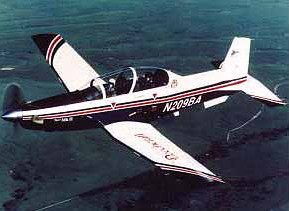
"The services recognize that the T-6A Texan II brings enhanced safety, superior performance and significant cost savings over current training aircraft," Schuster said. "We anticipate many international customers will want to take advantage of the T-6A's qualities, including a secure, long-term production line."
The U.S. Air Force began training pilots in the T-6A at Moody Air Force Base (Ga.) in October. In addition, the NATO Flying Training in Canada program purchased 24 T-6As and has been training pilots with the T-6A for more than a year. The Hellenic Air Force of Greece ordered 45 aircraft, of which 17 have been delivered.
France Orders 20 More Rafale Fighters
The French Ministry of Defence has ordered 20 more Rafale fighters from French aircraft manufacturer Dassault. The French Air Force will receive twelve and the French Navy eight.
This order supplements the contract placed in 1999 and brings to 61 the number of Rafale ordered by France (36 for the Air Force, 25 for the Navy). Of these 61 aircraft, 10 were delivered in 2001 and 13 more will be delivered in 2002.
The first naval squadron was formed in May last year and two Rafale are currently embarked on the Charles-de-Gaulle aircraft carrier. The two-seater version, ordered at the end of 2001, will be delivered from 2008.
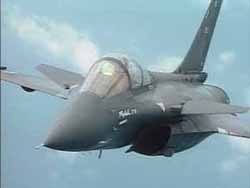
The first Air Force squadron will be formed in 2006.
In addition, the Ministry for Defense is developing the general-purpose standard F2 air-to-air and air-to-ground missile that will equip the Rafale and has begun the definition phase for the future F3 missile.
Gripen International Awarded Hungarian Contract
FMV (The Swedish Defence Materiel Administration) has awarded Gripen International, owned jointly by Saab of Sweden and the United Kingdom's BAE SYSTEMS, a contract for the adaptation and support of Swedish Air Force Gripen swing-role fighters designated for use by the Hungarian Air Force.
Gripen International will manage the contract as prime contractor and award a number of sub-contracts to ensure the Hungarian requirements are met. The main sub-contract will be to Saab AB (approximately SEK 1 billion) to adapt the aircraft to Hungarian needs and support the aircraft over its 10 year service period.
The company will be responsible for adapting Swedish Gripen aircraft to the specification required by the government of Hungary for the modernisation of its air force to meet national and NATO defense needs.
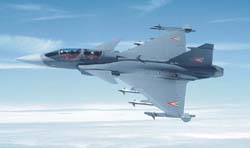
"Swedish Air Force variants of Gripen have already operated successfully with aircraft from NATO forces in PFP exercises. Our work will ensure that Hungarian Air Force Gripen fighters are fully NATO compatible and interoperable and will allow the Hungarian Air Force to maximise its contribution for NATO's collective defence," said Ian McNamee, managing director, Gripen International.
Under the government-to-government lease agreement, 14 Gripen fighters will be delivered to Hungary from Sweden in batches, beginning late 2004. The Hungarian Air Force's Gripen squadron will become fully operational during 2005.
Initial training of pilots and technicians will be carried out in Sweden, while UK Government support will provide Hungarian aircrew and other personnel with English language training and experience of NATO operations, as required.
Second AARGM Test Firing Successful
The second guided test vehicle missile firing of the US Navy's Advanced Technology Demonstration (ATD) of the Advanced Anti-Radiation Guided Missile (AARGM) programme was successfully completed on 19 December at the Naval Air Systems Command (NAVAIR) Weapons Division test range at China Lake in California.
The missile successfully identified, tracked, and guided itself to the simulated air defence radar target, passing within lethal radius of the warhead and impacting within the specified missile impact zone.

AARGM is an advanced, multi-mode seeker, combining passive anti-radiation homing and active millimetre wave sensors coupled with a GPS-aided inertial navigation system. The seeker is integrated on the AGM-88 High Speed Anti-Radiation Missile (HARM) airframe. AARGM is designed to improve the US Navy's capability to detect, locate and destroy enemy air defences.
The AARGM test missile was launched from a NAVAIR Weapons Division Test Squadron F/A-18. The specific test objectives accomplished during this test included:
Science and Applied Technology is currently under contract to develop the AARGM seeker, and is working in partnership with NAVAIR Weapons Division for the development and demonstration of the Quick Bolt ACTD.
[ Send Us News | Archives ]
by Gail Helmer
Wednesday January 02, 2002
- Medal of Honor SP Demo Released
- Silent Hunter 2 Project V2.0
- Global Hawk Crashes After Afghan Mission
- Osprey To Enter Two-Year Flight Test Programme
- JASSM Gets Go-Ahead For Low-Rate Initial Production
- Raytheon Aircraft Awarded T-6A Contract
- France Orders 20 More Rafale Fighters
- Gripen International Awarded Hungarian Contract
- Second AARGM Test Firing Successful
Medal of Honor SP Demo Released
Blues News has reported that the single-player demo of Medal of Honor: Allied Assault has surfaced online a day or so ago, apparently uploaded from a foreign magazine's cover CD-ROM. While it was originally not intended to be released online so soon, the massive 175 MB ZIP download is available for download here.
Silent Hunter 2 Project V2.0
Naval Warfare Simulations has that the NWS Silent Hunter 2 Project V2.0 is now posted. Several new graphics, sounds, and data updates with this latest version.
Military News
Global Hawk Crashes After Afghan Mission
A US Air Force RQ-4A Global Hawk unmanned aerial vehicle on a routine mission in support of US operations in Afghanistan crashed at 0830 GMT on 30 December. According to US Central Command it was returning to its undisclosed operating base when the accident occurred.
Central Command said the crash was "...not the result of enemy fire and the aircraft will be recovered."

The Global Hawk is an unmanned reconnaissance and surveillance system designed to provide military commanders with high resolution, near real-time imagery of large geographic areas. Still in its development phase, it has been pressed into service because of its long endurance over a target.
The aircraft was one of two in the theatre.
Osprey To Enter Two-Year Flight Test Programme
The troubled V-22 Osprey aircraft will go through a two-year flight test programme, said Pete Aldridge, US Defense Undersecretary for acquisition, technology and logistics.
"I've had some serious doubts about the safety, reliability and operational suitability of the V-22," Aldridge said during a Pentagon press conference Dec. 21. "I personally still have some doubts, but the only way to prove the case is to put the airplane back into flight test, and we're going to do that."
Marine Corps plans to buy 360 and Navy and Air Force plans to buy 50 each of the tilt-rotor aircraft were put on hold following two crashes that killed 23 Marines in April and December 2000.

Several "blue ribbon" groups that looked into the crashes and the programme have recommended a number of changes.
The new flight test programme will start in April 2002. It will be a comprehensive, two-year look at the aircraft. The tests will further explore the occurrence called vortex ring state, deemed responsible for the first crash of a V- 22 in Arizona that killed 19 Marines.
Aldridge said the tests also must explore shipboard compatibility. For example, he noted the need to look at what happens when one rotor is over the flight deck and the other is over the side of the ship, conditions which could include take-off, landing or craft on deck.
He wants the test to also explore low-speed hover conditions, such as landing when the props blow up dust, debris, snow and other things. The testing will also include combat manoeuvrability and formation flying, including refueling conditions.
Aldridge said he and Navy Secretary Gordon England would assess the testing programmes at various posts along the way. He said the flight-test hurdles would be event-driven rather than schedule-driven. Tests will not move to new areas until engineers fully understand the results of earlier testing.
"We'll not be driven by trying to accomplish something in a certain period of time," he said.
DoD has slowed down production of the V-22 to the minimum sustaining level. This will allow changes to be made to production aircraft. Aircraft already built will be retrofitted.
JASSM Gets Go-Ahead For Low-Rate Initial Production
US Undersecretary of Defense Pete Aldridge has given the Joint Air-to-Surface Standoff Missile (JASSM) programme the go-ahead for low-rate initial production. This decision will give the Air Force combat capability on the F-16 Fighting Falcons and B-52 Stratofortresses by 2003.
JASSM is a joint Air Force and Navy programme developed and produced by Lockheed-Martin Integrated Systems. JASSM employs stealth to penetrate enemy air defences at ranges of more than 200 miles and GPS coupled with a terminal seeker to attack high-value targets. Unlike current cruise missiles, JASSM can be launched off most types of aircraft in the Air Force inventory. The 2,000-pound class weapon is planned for deployment on the B-1B Lancer, B-2 Spirit, B-52, F-16, and the Navy's F/A-18 E/F Hornet.

"We have a low-cost, high performance programme and we came in below the objective of $400K in (fiscal) '95 dollars," said Terry Little, JASSM Air Force programme director. As a result, the Air Force has increased its buy from 2,400 to 3,700 missiles.
"JASSM is a flagship programme for acquisition excellence," said Dr. James G. Roche, secretary of the Air Force. "Not only do our combat forces get an unprecedented precision attack capability, but they get it at an affordable price never before achieved on a cruise missile program".
Air Force officials said the service plans to make the decision for full-rate production in late 2003.
Raytheon Aircraft Awarded T-6A Contract
Raytheon Aircraft has been awarded its largest military contract ever -- a one-year contract with four one-year options for the production of more than 230 T-6A Texan II aircraft, associated ground-based training devices and technical support. The one-year contract for 40 aircraft is valued at $193 million and when all options are exercised the total potential value will be approximately $1.22 billion.
The Joint Primary Aircraft Training System (JPATS) program calls for nearly 800 aircraft through the year 2017. To date, the U.S. Air Force and U.S. Navy have ordered 168 aircraft. This most recent contract, with options, covers the production of an additional 234 aircraft and ground-based training devices through the years 2002-2006, with deliveries beginning in 2004. The total value of the acquisition program to date, including options, is $2.1 billion.

"The services recognize that the T-6A Texan II brings enhanced safety, superior performance and significant cost savings over current training aircraft," Schuster said. "We anticipate many international customers will want to take advantage of the T-6A's qualities, including a secure, long-term production line."
The U.S. Air Force began training pilots in the T-6A at Moody Air Force Base (Ga.) in October. In addition, the NATO Flying Training in Canada program purchased 24 T-6As and has been training pilots with the T-6A for more than a year. The Hellenic Air Force of Greece ordered 45 aircraft, of which 17 have been delivered.
France Orders 20 More Rafale Fighters
The French Ministry of Defence has ordered 20 more Rafale fighters from French aircraft manufacturer Dassault. The French Air Force will receive twelve and the French Navy eight.
This order supplements the contract placed in 1999 and brings to 61 the number of Rafale ordered by France (36 for the Air Force, 25 for the Navy). Of these 61 aircraft, 10 were delivered in 2001 and 13 more will be delivered in 2002.
The first naval squadron was formed in May last year and two Rafale are currently embarked on the Charles-de-Gaulle aircraft carrier. The two-seater version, ordered at the end of 2001, will be delivered from 2008.

The first Air Force squadron will be formed in 2006.
In addition, the Ministry for Defense is developing the general-purpose standard F2 air-to-air and air-to-ground missile that will equip the Rafale and has begun the definition phase for the future F3 missile.
Gripen International Awarded Hungarian Contract
FMV (The Swedish Defence Materiel Administration) has awarded Gripen International, owned jointly by Saab of Sweden and the United Kingdom's BAE SYSTEMS, a contract for the adaptation and support of Swedish Air Force Gripen swing-role fighters designated for use by the Hungarian Air Force.
Gripen International will manage the contract as prime contractor and award a number of sub-contracts to ensure the Hungarian requirements are met. The main sub-contract will be to Saab AB (approximately SEK 1 billion) to adapt the aircraft to Hungarian needs and support the aircraft over its 10 year service period.
The company will be responsible for adapting Swedish Gripen aircraft to the specification required by the government of Hungary for the modernisation of its air force to meet national and NATO defense needs.

"Swedish Air Force variants of Gripen have already operated successfully with aircraft from NATO forces in PFP exercises. Our work will ensure that Hungarian Air Force Gripen fighters are fully NATO compatible and interoperable and will allow the Hungarian Air Force to maximise its contribution for NATO's collective defence," said Ian McNamee, managing director, Gripen International.
Under the government-to-government lease agreement, 14 Gripen fighters will be delivered to Hungary from Sweden in batches, beginning late 2004. The Hungarian Air Force's Gripen squadron will become fully operational during 2005.
Initial training of pilots and technicians will be carried out in Sweden, while UK Government support will provide Hungarian aircrew and other personnel with English language training and experience of NATO operations, as required.
Second AARGM Test Firing Successful
The second guided test vehicle missile firing of the US Navy's Advanced Technology Demonstration (ATD) of the Advanced Anti-Radiation Guided Missile (AARGM) programme was successfully completed on 19 December at the Naval Air Systems Command (NAVAIR) Weapons Division test range at China Lake in California.
The missile successfully identified, tracked, and guided itself to the simulated air defence radar target, passing within lethal radius of the warhead and impacting within the specified missile impact zone.

AARGM is an advanced, multi-mode seeker, combining passive anti-radiation homing and active millimetre wave sensors coupled with a GPS-aided inertial navigation system. The seeker is integrated on the AGM-88 High Speed Anti-Radiation Missile (HARM) airframe. AARGM is designed to improve the US Navy's capability to detect, locate and destroy enemy air defences.
The AARGM test missile was launched from a NAVAIR Weapons Division Test Squadron F/A-18. The specific test objectives accomplished during this test included:
- Interoperability with the aircraft's mission and command launch computers;
- Detection, identification and tracking of the target by the missile's anti-radiation homing subsystem;
- Guidance of the missile to the target via the missile's integrated guidance software; and
- Target search, detection, tracking and data collection by the missile's terminal millimetre wave seeker.
Science and Applied Technology is currently under contract to develop the AARGM seeker, and is working in partnership with NAVAIR Weapons Division for the development and demonstration of the Quick Bolt ACTD.
